Golconda diamonds
The Golconda Diamonds are Indian diamonds mined in a specific geographic area in the present-day Andhra Pradesh and Telangana states of India. During the rule of the historic Qutb Shahi dynasty (16th century–17th century CE), also known as the "Golconda Sultanate", diamonds from these mines (especially Kollur Mine in Andhra Pradesh) were transported to the city of Hyderabad to be cut, polished, evaluated and sold. Golconda in Hyderabad established itself as a diamond trading centre and, until the end of the 19th century, the Golconda market was the primary source of the finest and one of the largest diamonds in the world. Thus, the legendary name 'Golconda Diamond' became synonymous with Golconda itself. The Golconda region has produced some of the world's most famous diamonds, including the colourless Koh-i-Noor (now owned by the United Kingdom), the blue Hope (United States), the pink Daria-i-Noor (Iran), the white Regent (France), the Dresden Green (Germany), and the colourless Orlov (Russia), Nizam and Jacob (India), as well as the now lost diamonds Florentine Yellow, Akbar Shah and Great Mogul.

One of the most popular diamond mines was Kollur Mine (presently in Guntur district, Andhra Pradesh). There were also other mines around the River Krishna in South India. Along with diamonds, the region also became a trade centre for metal-ware, pearls, spices and textiles. According to The New Indian Express (22 October 2016), "the Hyderabad based historian, Muhammad Safiullah says such was the trade that the estimated output from all mines in Golconda was estimated to be around 12 million carats".
History
Golconda sultanate was located in between the two major sea ports of India, Surat and Machilipatnam. The town was developed as a trade centre and, under the patronage of the Qutb Shahi rulers, a thriving market particularly of diamonds was developed nearby the Golconda fort, the work force involved in the diamond trading was up to 100,000 people. The medieval diamond trade drew travellers from around the world and the ruling patrons constructed facilities and provided security for traders to stay and do business, particularly those travelling from Europe and central Asia. According to Manu S. Pillai, (The Hindu, 5 November 2016), Jean-Baptiste Tavernier, renowned French traveller and jeweller, claimed to have seen a flat diamond called the Great Table diamond kept in a dungeon in Golconda.[1][2][3][4][5] Jean de Thévenot and François Bernier were also French traders in 'Golconda Diamonds'.[6][7][8]
Notable diamonds
Some of the most famous diamonds from Golconda are:
- Akbar Shah, 73.6 carats (14.72 g) cut; current owner unknown, but possibly the estate of the late late Fātehsinh Rāo Gaekwāḑ.
- Archduke Joseph Diamond, 78.54 carats (15.708 g) cut; sold to an anonymous buyer in 1993.
- Beau Sancy, 35 carats (7.0 g) cut; sold to an anonymous buyer in 2012.
- Daria-i-Noor, 182 carats (36.4 g); in the Iranian Crown.
- Dresden Green Diamond, 41 carats (8.2 g); in the New Green Vault, Staatliche Kunstsammlungen Dresden.
- Florentine Diamond, 137.27 carats (27.5 g); lost.
- Great Mogul Diamond, 280 carats (56 g) cut, 787 carats (157.4 g) rough; lost after Nader Shah sacked Delhi.
- Hope Diamond, 67 carats (13.4 g); in the American Museum of Natural History, Washington.
- Jacob Diamond 184.75 carats (36.950 g) cut; in the Reserve Bank of India vaults in Mumbai.
- Koh-i-Noor, 105.6 carats (21.12 g) (793 carats (158.6 g) rough, 186 carats (37.2 g) cut, further cut for Crown Jewels); in the British Crown Jewels, London.
- Nassak Diamond, 43.38 carats (8.676 g) cut; owned by American Edward J. Hand.
- Nizam Diamond, 340 carats (68.0 g).
- Noor-ul-Ain, 60 carats (12 g) cut; in the National Treasury of Iran.
- Orlov Diamond, 189.62 carats (37.9 g) cut; part of the Diamond Fund at the Moscow Kremlin, Russia.
- Pigot Diamond, 47.38 carats (9.476 g) cut; sold to Muhammad Ali Pasha, Khedive of Egypt in the 1820s. Current fate unknown.
- Princie Diamond, 34.65 carats (6.930 g) cut; sold to an anonymous buyer in 2013.
- Regent Diamond, 140 carats (28.0 g); in the Galerie d'Apollon, Louvre, Paris.
- Sancy Diamond, 55.23 carats (11.046 g) cut; in the Galerie d'Apollon, Louvre, Paris.
- Shah Diamond, 88.7 carats (17.74 g) cut; part of the Diamond Fund at the Moscow Kremlin, Russia.
- Shah Jahan Diamond, 56.7 carats (11.34 g) in the Dar al Athar al Islamiyyah, Kuwait.
- Wittelsbach-Graff Diamond, 31.06 carats (6.212 g) cut; owned by Hamad bin Khalifa Al Thani, former ruler of Qatar.
Gallery
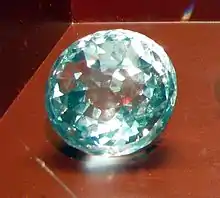 A copy of the 'Great Mogul Diamond'
A copy of the 'Great Mogul Diamond'_cancelled.jpg.webp) Shah Diamond, 1971 postage stamp
Shah Diamond, 1971 postage stamp_black.png.webp) Sancy Diamond (illustration from the Swedish encyclopedia Nordisk familjebok)
Sancy Diamond (illustration from the Swedish encyclopedia Nordisk familjebok)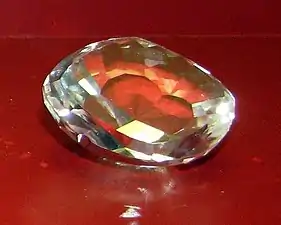 Glass replica of the Koh-i-Noor Diamond in its original form at the Reich der Kristalle museum in Munich
Glass replica of the Koh-i-Noor Diamond in its original form at the Reich der Kristalle museum in Munich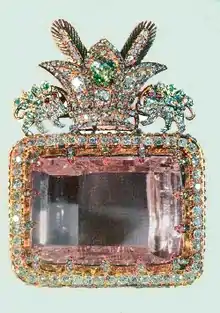 Darya-e Noor Diamond
Darya-e Noor Diamond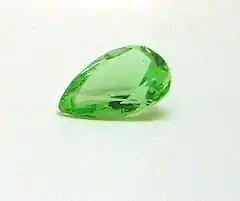 Diamond copy of the famous Dresden Grün from the "Reich der Kristalle" museum in Munich
Diamond copy of the famous Dresden Grün from the "Reich der Kristalle" museum in Munich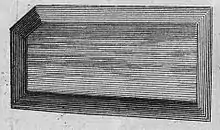
Legends
Out of 38 diamond mines of India, 23 were located in the Golconda Sultanate, making it the 'Diamond Capital' of the past.[6] It was considered a point of pride by any ruler to be the owner of one of the Golconda Diamonds. The top four pink diamonds of the world are from Golconda.[9]
References
- Gomelsky, Victoria (20 March 2011). "The Market for Golconda Diamonds Has Mushroomed". The New York Times. Retrieved 30 November 2016.
- Shanker, K Shiva (22 October 2016). "Famed golconda diamonds may still fetch record prices". The New Indian Express. Retrieved 30 November 2016.
- Srivathsan, A; Venkateshwarlu, K (17 June 2016). "Golconda diamond fetches world record price". The Hindu. Retrieved 30 November 2016.
- Pilli, Manu S (5 November 2016). "Delving into the rich and often bloody history of Golconda Fort". The Hindu. Retrieved 30 November 2016.
- "Is Telangana sitting on a bed of diamonds?". Zee News. 10 August 2015. Retrieved 30 November 2016.
- Gupta, Harsh K (2000). Deccan Heritage. Indian National Science Academy and University Press. p. 141. ISBN 9788173712852. Retrieved 7 May 2017.
- Erlich, Edward; Hausel, W. Dan (2002). Diamond Deposits. SME. pp. 3–4. ISBN 9780873352130. Retrieved 7 May 2017.
- "On Golconda Rock". Outlook India. 12 November 2007. Retrieved 7 May 2017.
- "Princie Diamond: Rare Indian gem sells for $39m". BBC News. 17 April 2013. Retrieved 2 December 2016.
External links
| Wikimedia Commons has media related to Golconda Diamonds. |